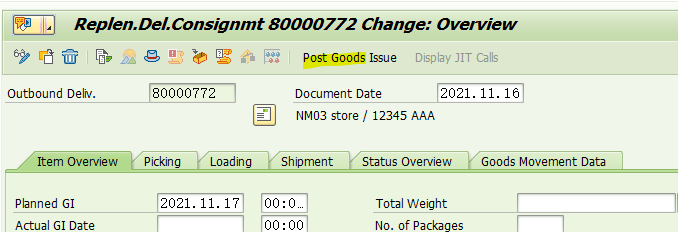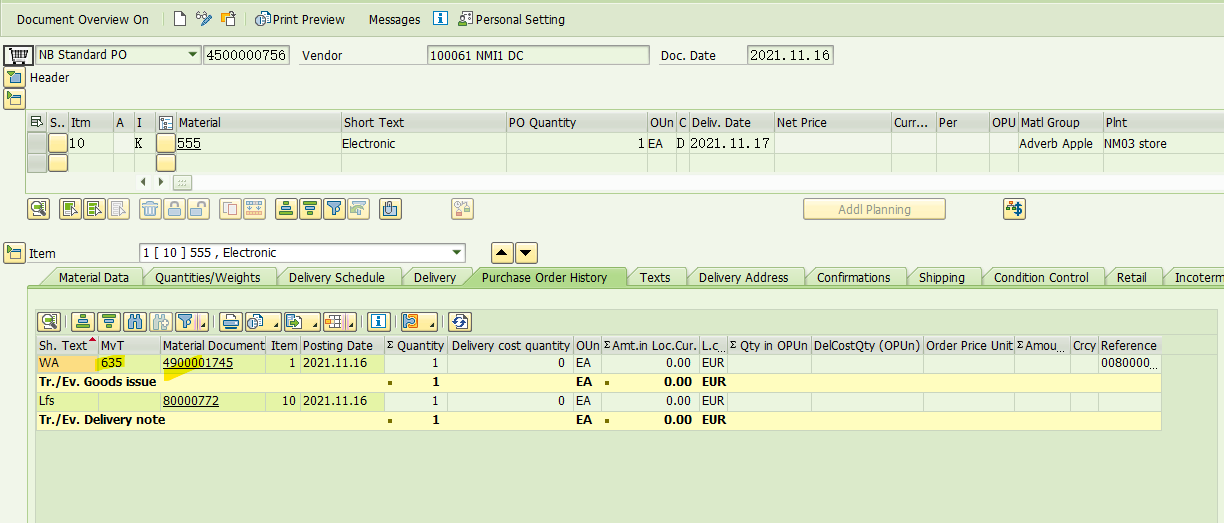
- SAP Community
- Products and Technology
- Enterprise Resource Planning
- ERP Blogs by Members
- My First Vendor Consignment Inter-Company STO
Enterprise Resource Planning Blogs by Members
Gain new perspectives and knowledge about enterprise resource planning in blog posts from community members. Share your own comments and ERP insights today!
Turn on suggestions
Auto-suggest helps you quickly narrow down your search results by suggesting possible matches as you type.
Showing results for
dicksonjyl
Active Participant
Options
- Subscribe to RSS Feed
- Mark as New
- Mark as Read
- Bookmark
- Subscribe
- Printer Friendly Page
- Report Inappropriate Content
11-16-2021
8:30 AM
My First Vendor Consignment Inter-Company STO
In a retail industry SAP project that I am concerned about, there is a scenario in which the head office imports goods and transfers them to domestic sales companies, and then the stores of sales companies sell those goods to customers. This is a typical cross company purchase, or inter- company STO (stock transfer document). This is a common business scenario for SAP projects of many large group customers.
However, the special feature of this project is that the goods purchased by the sales company from the head office adopt the consignment mode, It means that this is an inter-company STO of supplier consignment mode.
This is a new scene for me, which aroused my curiosity. Driven by the desire for knowledge, I actualize the inter company STO function of vendor consignment model on an testing environment of SAP retail.
This blog describes the implementation of this process in SAP system.
Part I:process step demo
1, ME21N to create inter-company STO document 4500000756.

Item category is K, that indicate that it is vendor consignment STO.
2, Execute tcode VL10B to create outbound delivery for this STO.

Input the STO number, then click Execute, SAP go to below screen,

Select the item and click button Background, then we got below screen,

It means that the outbound delivery was created successfully. Click the STO document number, SAP goto below ME23N screen,

In Purchase Order History Tab, we see the outbound delivery document number.
VL03N to display this outbound delivery document,

See its Header data, the delivery type is NK(Replenishment Delivery Consignment).See below screen shot:

3, Execute the tcode VL02N to do picking and goods issue.

Inut the batch number and picked quantity. And then click Post goods Issue button.

After posting, SAP generated a material document with 635 movement type,


4,Execute the transaction code MIGO to do goods receipt for this STO 4500000756.

Select A01 (Goods Receipt), R01(Purchase Order), input the STO document number, click Enter key,

SAP will receipt the goods using movement type 101, special indicator K.
After posting, SAP generated a goods receipt material document, see below screen:

Part II – Key Master Data Setting
1,the material master data needs to be extended the sales view.
2,It is necessary to maintain the goods issue store or DC as a vendor. The vendor needs to be extended in the purchasing organization of the receiving company.
3,It is necessary to maintain the receiving store as a customer, and extend the customer in the sales area of the goods issue company.
Part III – key backend configuration
1, In the STO setup configuration we need to assign a delivery type for consignment STO.


Set the value of Delivery type consignment field as NK.
2,Specify the STO document type for the issue plant.

Assign Document Type, One-Step Procedure, Underdelivery Tolerance

In this configuration,NMI1 is the DC of headquarter company, NMI2 is a store of headquarter company. Stock transfer between NMI1 and NMI2 is a intra-company STO, we use document type UB.
NM01/NM02/NM03/NMDC are the stores/DC of sales company. So the stock transfer from NMI1 to NM01/02/03/NMDC is the inter-company STO (cross-company STO), we use document type NB.
The conclusion is that in SAP system, we can realize the vendor consignment mode inter-company STO scenario. This scenario often happened in retail industry.
- SAP Managed Tags:
- SAP S/4HANA,
- MM (Materials Management)
5 Comments
You must be a registered user to add a comment. If you've already registered, sign in. Otherwise, register and sign in.
Labels in this area
-
"mm02"
1 -
A_PurchaseOrderItem additional fields
1 -
ABAP
1 -
ABAP Extensibility
1 -
ACCOSTRATE
1 -
ACDOCP
1 -
Adding your country in SPRO - Project Administration
1 -
Advance Return Management
1 -
AI and RPA in SAP Upgrades
1 -
Approval Workflows
1 -
ARM
1 -
ASN
1 -
Asset Management
1 -
Associations in CDS Views
1 -
auditlog
1 -
Authorization
1 -
Availability date
1 -
Azure Center for SAP Solutions
1 -
AzureSentinel
2 -
Bank
1 -
BAPI_SALESORDER_CREATEFROMDAT2
1 -
BRF+
1 -
BRFPLUS
1 -
Bundled Cloud Services
1 -
business participation
1 -
Business Processes
1 -
CAPM
1 -
Carbon
1 -
Cental Finance
1 -
CFIN
1 -
CFIN Document Splitting
1 -
Cloud ALM
1 -
Cloud Integration
1 -
condition contract management
1 -
Connection - The default connection string cannot be used.
1 -
Custom Table Creation
1 -
Customer Screen in Production Order
1 -
Data Quality Management
1 -
Date required
1 -
Decisions
1 -
desafios4hana
1 -
Developing with SAP Integration Suite
1 -
Direct Outbound Delivery
1 -
DMOVE2S4
1 -
EAM
1 -
EDI
2 -
EDI 850
1 -
EDI 856
1 -
edocument
1 -
EHS Product Structure
1 -
Emergency Access Management
1 -
Energy
1 -
EPC
1 -
Financial Operations
1 -
Find
1 -
FINSSKF
1 -
Fiori
1 -
Flexible Workflow
1 -
Gas
1 -
Gen AI enabled SAP Upgrades
1 -
General
1 -
generate_xlsx_file
1 -
Getting Started
1 -
HomogeneousDMO
1 -
IDOC
2 -
Integration
1 -
Learning Content
2 -
LogicApps
2 -
low touchproject
1 -
Maintenance
1 -
management
1 -
Material creation
1 -
Material Management
1 -
MD04
1 -
MD61
1 -
methodology
1 -
Microsoft
2 -
MicrosoftSentinel
2 -
Migration
1 -
MRP
1 -
MS Teams
2 -
MT940
1 -
Newcomer
1 -
Notifications
1 -
Oil
1 -
open connectors
1 -
Order Change Log
1 -
ORDERS
2 -
OSS Note 390635
1 -
outbound delivery
1 -
outsourcing
1 -
PCE
1 -
Permit to Work
1 -
PIR Consumption Mode
1 -
PIR's
1 -
PIRs
1 -
PIRs Consumption
1 -
PIRs Reduction
1 -
Plan Independent Requirement
1 -
Premium Plus
1 -
pricing
1 -
Primavera P6
1 -
Process Excellence
1 -
Process Management
1 -
Process Order Change Log
1 -
Process purchase requisitions
1 -
Product Information
1 -
Production Order Change Log
1 -
Purchase requisition
1 -
Purchasing Lead Time
1 -
Redwood for SAP Job execution Setup
1 -
RISE with SAP
1 -
RisewithSAP
1 -
Rizing
1 -
S4 Cost Center Planning
1 -
S4 HANA
1 -
S4HANA
3 -
Sales and Distribution
1 -
Sales Commission
1 -
sales order
1 -
SAP
2 -
SAP Best Practices
1 -
SAP Build
1 -
SAP Build apps
1 -
SAP Cloud ALM
1 -
SAP Data Quality Management
1 -
SAP Maintenance resource scheduling
2 -
SAP Note 390635
1 -
SAP S4HANA
2 -
SAP S4HANA Cloud private edition
1 -
SAP Upgrade Automation
1 -
SAP WCM
1 -
SAP Work Clearance Management
1 -
Schedule Agreement
1 -
SDM
1 -
security
2 -
Settlement Management
1 -
soar
2 -
SSIS
1 -
SU01
1 -
SUM2.0SP17
1 -
SUMDMO
1 -
Teams
2 -
User Administration
1 -
User Participation
1 -
Utilities
1 -
va01
1 -
vendor
1 -
vl01n
1 -
vl02n
1 -
WCM
1 -
X12 850
1 -
xlsx_file_abap
1 -
YTD|MTD|QTD in CDs views using Date Function
1
- « Previous
- Next »
Related Content
- Advance Return Management complete configuration(SAP ARM) in Enterprise Resource Planning Blogs by Members
- Negative Stock Handling in Enterprise Resource Planning Blogs by Members
- SAP S/4HANA Cloud Private Edition | 2023 FPS01 Release – Part 1 in Enterprise Resource Planning Blogs by SAP
- Advance shipment via Procurement in Enterprise Resource Planning Blogs by Members
- Intercompany with third party vendor in Enterprise Resource Planning Q&A
Top kudoed authors
| User | Count |
|---|---|
| 6 | |
| 2 | |
| 2 | |
| 2 | |
| 2 | |
| 2 | |
| 1 | |
| 1 | |
| 1 |